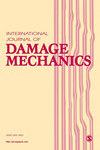循环加载下岩石宏观断裂前的能量特征
IF 3.9
2区 工程技术
Q2 MATERIALS SCIENCE, MULTIDISCIPLINARY
引用次数: 0
摘要
为了阐明含缺陷类岩石材料在循环荷载作用下的损伤演化规律,采用预制非穿透裂纹的石膏试样对脆性材料在循环荷载作用下破坏过程中的能量进行了定量研究。结果表明:在循环荷载作用下,能量的积累、转化和释放规律能够有效反映类岩材料的损伤演化过程。在石膏试样的损伤过程中,非穿透性裂纹的数量会影响试样的弹性能密度、总能密度和耗散能密度。随着循环次数的增加,新裂纹的表面自由能有一定程度的增加。推导了循环荷载作用下石膏试件的总能、蓄能、耗散能和损伤的表达式,并通过试验结果进行了验证。对裂纹表面能进行了定量分析和计算,并对微裂纹表面自由能进行了估计和分析。这些发现对于从能量积累、转化和释放的角度认识剥落、崩塌、冲击地压等深部岩石工程中岩石破坏和岩石工程灾害的机理具有重要意义。本文章由计算机程序翻译,如有差异,请以英文原文为准。
Energy characteristics of rocks prior to macroscopic fracture under cyclic loading
To clarify the damage evolution of rock-like materials with defects under cyclic loading, gypsum specimens containing prefabricated nonpenetrating crack(s) are employed to undertake a quantitative study of the energy in the failure process of brittle materials under cyclic loading. The results show that under cyclic loading, the laws of energy accumulation, transformation, and release can effectively reflect the damage evolution process of rock-like materials. In the damage process of gypsum specimen, the number of nonpenetrating cracks can influence the elastic energy density, the total energy density, and dissipated energy density. The surface free energy of new cracks tends to increase to a certain extent as the number of cycles increases. Additionally, the expressions for the total energy, stored energy, dissipated energy, and damage of the gypsum specimen under cyclic loading are derived and tested through the experimental results. A quantitative analysis and calculation of the crack surface energy have also been conducted, along with an estimation and analysis of the microcrack surface free energy. These findings are of great significance for understanding the mechanisms of rock failure and rock engineering disasters in deep rock engineering, such as spalling, collapse, and rock burst, from the perspective of energy accumulation, transformation, and release.
求助全文
通过发布文献求助,成功后即可免费获取论文全文。
去求助
来源期刊

International Journal of Damage Mechanics
工程技术-材料科学:综合
CiteScore
8.70
自引率
26.20%
发文量
48
审稿时长
5.4 months
期刊介绍:
Featuring original, peer-reviewed papers by leading specialists from around the world, the International Journal of Damage Mechanics covers new developments in the science and engineering of fracture and damage mechanics.
Devoted to the prompt publication of original papers reporting the results of experimental or theoretical work on any aspect of research in the mechanics of fracture and damage assessment, the journal provides an effective mechanism to disseminate information not only within the research community but also between the reseach laboratory and industrial design department.
The journal also promotes and contributes to development of the concept of damage mechanics. This journal is a member of the Committee on Publication Ethics (COPE).
 求助内容:
求助内容: 应助结果提醒方式:
应助结果提醒方式:


